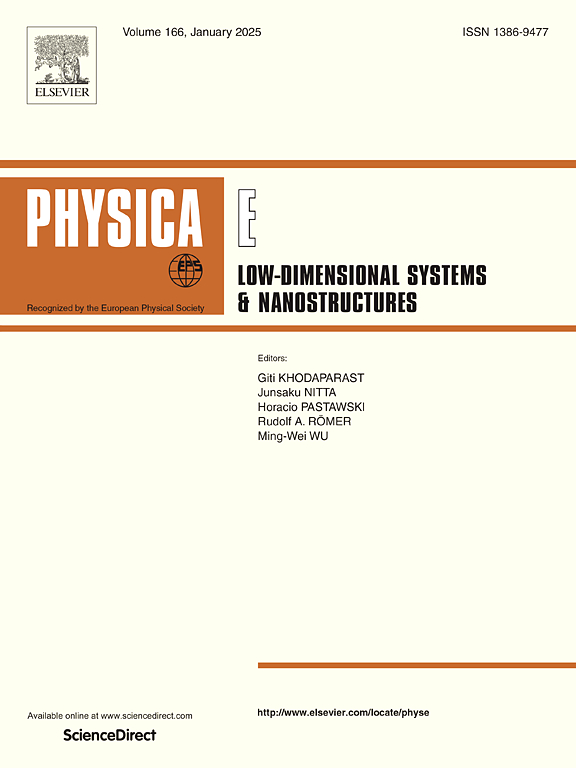Theoretical predicted topological properties of Janus SrInGaTe4
IF 2.9
3区 物理与天体物理
Q3 NANOSCIENCE & NANOTECHNOLOGY
Physica E-low-dimensional Systems & Nanostructures
Pub Date : 2025-04-04
DOI:10.1016/j.physe.2025.116257
引用次数: 0
Abstract
Two-dimensional (2D) Janus structures have emerged as promising materials due to their novel physical properties and wide-ranging potential applications. The symmetry breaking inherent in Janus structures raises an intriguing question: do their topological properties persist despite this asymmetry? Both theoretically predicted Janus SrInGaTe4 and its parent compound SrGa2Te4 retain their topological characteristics when spin-orbit coupling (SOC) is considered. Furthermore, Rashba-type spin splitting is observed at both the conduction band minimum (CBM) and the valence band maximum (VBM), attributed to the inversion asymmetry. The electronic properties of SrInGaTe4 can be modulated using biaxial strain and external electric fields. Under a tensile strain of 6 %, the inverted band gap of SrInGaTe4 increases significantly from 40 meV (at zero strain) to 124 meV. Similarly, an applied vertical electric field of 0.2V/Å enlarges the inverted band gap to 84 meV. Topological invariants (Z2) calculations reveal that SrInGaTe4 transitions to a normal insulator under a compressive strain of −2 %. Additionally, an applied electric field induces a topological phase transition from non-trivial to trivial, with a critical field of approximately −0.2V/Å. This study demonstrates that both strain and electric fields can effectively tune the topological properties of select 2D materials. These findings provide valuable insights for the design and development of advanced spintronic devices.
理论预测Janus SrInGaTe4的拓扑性质
二维Janus结构由于其新颖的物理特性和广泛的潜在应用而成为有前途的材料。Janus结构固有的对称性破缺引发了一个有趣的问题:尽管存在这种不对称性,它们的拓扑特性是否仍然存在?当考虑自旋轨道耦合(SOC)时,理论预测Janus SrInGaTe4及其母体化合物SrGa2Te4保持其拓扑特征。此外,在导带最小值(CBM)和价带最大值(VBM)都观察到rashba型自旋分裂,这是由于反转不对称造成的。SrInGaTe4的电子特性可以通过双轴应变和外加电场进行调制。在6%的拉伸应变下,SrInGaTe4的反向带隙从40 meV(零应变)显著增加到124 meV。同样,施加0.2V/Å的垂直电场将反向带隙扩大到84 meV。拓扑不变量(Z2)计算表明,SrInGaTe4在压缩应变为- 2%时转变为正常绝缘体。此外,外加电场诱导从非平凡到平凡的拓扑相变,临界场约为- 0.2V/Å。该研究表明,应变场和电场都可以有效地调整选定的二维材料的拓扑性质。这些发现为先进自旋电子器件的设计和开发提供了有价值的见解。
本文章由计算机程序翻译,如有差异,请以英文原文为准。
求助全文
约1分钟内获得全文
求助全文
来源期刊
CiteScore
7.30
自引率
6.10%
发文量
356
审稿时长
65 days
期刊介绍:
Physica E: Low-dimensional systems and nanostructures contains papers and invited review articles on the fundamental and applied aspects of physics in low-dimensional electron systems, in semiconductor heterostructures, oxide interfaces, quantum wells and superlattices, quantum wires and dots, novel quantum states of matter such as topological insulators, and Weyl semimetals.
Both theoretical and experimental contributions are invited. Topics suitable for publication in this journal include spin related phenomena, optical and transport properties, many-body effects, integer and fractional quantum Hall effects, quantum spin Hall effect, single electron effects and devices, Majorana fermions, and other novel phenomena.
Keywords:
• topological insulators/superconductors, majorana fermions, Wyel semimetals;
• quantum and neuromorphic computing/quantum information physics and devices based on low dimensional systems;
• layered superconductivity, low dimensional systems with superconducting proximity effect;
• 2D materials such as transition metal dichalcogenides;
• oxide heterostructures including ZnO, SrTiO3 etc;
• carbon nanostructures (graphene, carbon nanotubes, diamond NV center, etc.)
• quantum wells and superlattices;
• quantum Hall effect, quantum spin Hall effect, quantum anomalous Hall effect;
• optical- and phonons-related phenomena;
• magnetic-semiconductor structures;
• charge/spin-, magnon-, skyrmion-, Cooper pair- and majorana fermion- transport and tunneling;
• ultra-fast nonlinear optical phenomena;
• novel devices and applications (such as high performance sensor, solar cell, etc);
• novel growth and fabrication techniques for nanostructures

 求助内容:
求助内容: 应助结果提醒方式:
应助结果提醒方式:


